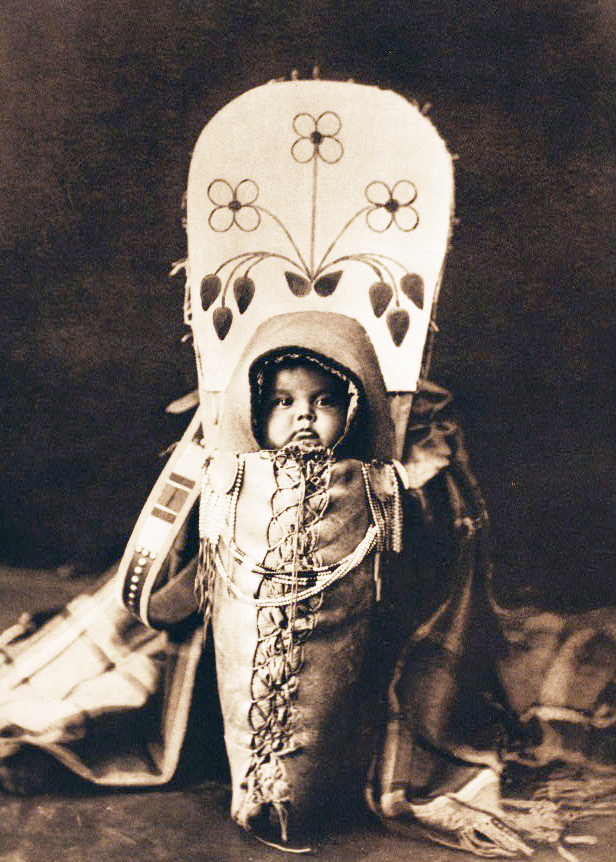The trauma model
Throughout history and prehistory children’s lives have been a nightmare about which our species is barely starting to become conscious. “Parents are the child’s most lethal enemy,” wrote Lloyd deMause, the founder of psychohistory. While paleo-anthropologists have found evidence of decapitated infants since the time of our pre-human ancestors, and while it was known that infanticide continued into the Paleolithic and the Neolithic periods, the emotional after-effects on the surviving siblings was appreciated by deMause with the publishing of The History of Childhood in 1974. As we will see in the third section substantiated by a hundred references, infanticidal parents were the rule, not the exception. Even in the so-called great civilizations the sacrifice of children was common. In Carthage urns have been found containing thousands of burned remains of children sacrificed by parents asking favors from the gods. It is believed that infants were burned alive.
Although in a far less sadistic way than in Carthage and other ancient states, and this explains the genius of the classic world, Greeks and Romans practiced infanticide in the form of exposure of newborns, especially girls. Euripides’ Ion describes the exposed infant as: “prey for birds, food for wild beasts to rend.” Philo was the first philosopher who made a clear statement against infanticide:
Some of them do the deed with their own hands; with monstrous cruelty and barbarity they stifle and throttle the first breath which the infants draw or throw them into a river or into the depths of the sea, after attaching some heavy substance to make them sink more quickly under its weight.
In some of his satires Juvenal openly criticized abortion, child abandonment, and the killing of adoptive children and stepchildren.
My first reaction in the face of such revelations was, naturally, a healthy skepticism. This moved me to purchase books about infanticide and histories of childhood not written by “psychohistorians,” but by common historians; and I started to pay special attention to certain kinds of news in the papers of which previously I scarcely gave any importance. One day in 2006 a notice caught my eye, stating that there are 32 million fewer women than men in India, and that the imbalance was caused by feticide. I recalled a photograph I had seen in the June 2003 National Geographic, showing a Bihar midwife in the rural North of India, rescuing a female baby abandoned under a bridge. Infanticide and selective abortion, particularly of girls, continue as I write this line. According to a Reproductive Rights conference in October 2007 in Hyderabad, India, statistics show that 163 million women are missing in Asia, compared to the proportion of the male population. They are the result of the exposure of babies, and especially of selective abortion facilitated by access to techniques such as prenatal testing and ultrasound imagery. These snippets of information gathered from newspapers, coupled with the scholarly treatises which I was reading, eradicated my original skepticism about the reality of infanticide.
But let’s return to psychohistory as developed by deMause. There are cultures far more barbarous than contemporary India as regards childrearing. In the recent past of the tribes of New Guinea and Australia, little brothers and sisters witnessed how parents killed one of their siblings and made the rest of the family share the cannibal feast. “They eat the head first,” wrote Géza Róheim in Psychoanalysis and Anthropology published in 1950. Gillian Gillison observed in Between Culture and Fantasy: a New Guinea Highlands Mythology, published in 1993, that the mother eats the son’s penis. And Fritz Poole wrote:
Having witnessed their parents’ mortuary anthropophagy, many of these children suddenly avoided their parents, shrieked in their presence, or expressed unusual fear of them. After such experiences, several children recounted dreams or constructed fantasies about animal-man beings with the faces or other features of particular parents who were smeared with blood and organs.
These passages are quoted in deMause’s The Emotional Life of Nations. Reading further in this work, one can also learn, as Wolfgang Lederer wrote when observing the tribes, that other primitives threw their newborns to the swine, who devoured them swiftly. Lederer also recounts that he saw one of these mothers burying her child alive:
The baby’s movements may be seen in the hole as it is suffocating and panting for breath; schoolchildren saw the movements of such a dying baby and wanted to take it out to save it. However, the mother stamped it deep in the ground and kept her foot on it…
Australian aboriginals killed approximately 30 percent of their infants, as reported by Gillian Cowlishaw in Oceania; and the first missionaries to Polynesia estimated that up to two-thirds of Polynesian children were killed by their parents. In a 2008 article I learned that infanticide continues in the islands even as of the time of reporting. Tribal women allege they have to kill their babies for fear they might become dreadful warriors as adults.
Another type of information that shocked me in deMause’s books was the frequency throughout history of the mutilation of children. Once more, my first reaction was a healthy skepticism. But I had no choice but to accept the fact that even today there are millions of girls whose genitals have been cut. The Emotional Life of Nations publishes a photograph of a panicked Cairo pubescent girl being held down by adults at the moment when her family has her mutilated. Every time I see that photo I have to turn away my head (the girl looks directly into the camera and her pain reaches me deeply). According to the French National Institute for Demographic Studies (INED), in 2007 there were between 100 and 140 million women who had had their genitals removed. The practice ranges from the partial cutting of the clitoris to the suturation of the vaginal orifice, the latter especially in Sub-Saharan Africa, some regions of the Middle East, and Southeast Asia. The INED study points out that in Ethiopia three-quarters of women have been genitally mutilated, and in Mali up to 90 percent. The practice is also carried out in Yemen, Indonesia and Malaysia.
In historic times there were a large number of eunuchs in Byzantium, and in the West mutilation was a common practice for boys. Verdun was notorious for the quantity of castrations performed, and in Naples signs hung above stores saying, “boys castrated here.” Castration was common as well in other cultures. DeMause observes that the testicles of boys between three and seven years were crushed or cut off. In China both the penis and the scrotum were cut, and in the Middle East the practice continued until recent times.

(A swaddled boy of the tribe Nez Perce, 1911.) DeMause’s books are eye-openers also about another practice that no school text of traditional anthropology had taught me: the tight swaddling of babies.
It is worth noting that historians, anthropologists, and ethnologists have been the target of fierce criticism by some psychohistorians for their failure to see the psychological after-effects brought about by such practices. Through the centuries, babies were swaddled by their mothers with swaddling clothes wrapped around their bodies, several times and tightly fastened while they screamed in their vain attempts at liberation. Before reading deMause the only thing I knew of such practice was when I as a boy saw a cartoon of a couple of Red Indians who had their baby swaddled, of which only a little head was visible crying big time, while the Indians walked on casually. Despite its being a comic strip, I remember it made a mark in my young memory because of the pity I felt for the baby boy and how I noted the parents’ indifference. This happened decades before I read Foundations of Psychohistory, wherein it is described that this practice was universal and that it goes back to our tribal ancestors. Even Alice Miller herself, the heroine of my third book of Hojas Susurrantes, was swaddled as a child. In Europe swaddling is still practiced in some rural parts of Greece. The sad spectacle of the swaddled newborns in Yugoslavia and Russia draws the visiting foreigners’ attention. Even in the city in which I was born a few friends have told me that some relatives swaddled their babies.
Those who have read my previous book would not be surprised that the man in the street has barely thought about the ravages that these practices—swaddling, mutilation, growing up knowing that mom and dad had abandoned or sacrificed a little sister—caused in the surviving siblings who witnessed it. What we have before us is the most potent taboo of the species: a lack of elemental consciousness of what parents do to their children. As we will see at the end of this book, some historians of infanticide who do not belong to the deMausean school estimate in astronomical figures the infanticide rate since the Paleolithic.
___________
The objective of the book is to present to the racialist community my philosophy of The Four Words on how to eliminate all unnecessary suffering. If life allows, the following week I will publish here the section on trauma model researcher Colin Ross. Those interested in obtaining a copy of Day of Wrath can request it: here.

6 replies on “Day of Wrath, 2”
I assume swaddling was done in the past as a practical measure to keep the baby from falling or climbing out when being carried. There would be less justification for swaddling a baby when indoors, although if a crib is lacking and there are things indoors that have the potential to be harmful to the baby if the baby is not constrained, then there is some justification for swaddling indoors as well.
An example of modern-day swaddling in the USA is the small plastic car seats for babies, when in a car, done to protect the baby while in the car and also protect it in case of a car crash or car accident.
Here’s a real crime against infant boys that is still widely done today in the USA: male circumcision. In the year I was born in the 1950s, the male-circumcision rate for baby boys was about 75%, and a few days after my birth in a USA hospital that crime was committed against myself. The last year for which I’ve seen data was the year 2000 when the USA male-circumcision rate was down to about 50%.
Circumcision should be a crime, but it’s not the prolonged torture that swaddling is.
While Alice Miller did a lot to expose child abuse, she was also a Jew who believed every White had a subconscious hatred of the Jew. Is she still your hero?
I started to read Miller in 2002. Didn’t know she was Jew until her death in 2010. I distanced myself from her since then. See my blog about her:
http://tort-miller.blogspot.mx/2013/01/alice-millers-nonsense-about-hitler.html
Yes, thank you, Cesar, for taking my question seriously and giving me good feedfback. BTW, this article on the trauma model and parents and Lloyd deMause I found very moving. I’ve never read deMause, but “The Emotional Life of Nations” seems relevant reading for today’s times. And even as I reach the age of 68, I find the issue about parents being the lethal enemy of the child still pertinent. Thank you for this article and the reading suggestions.
Welcome.